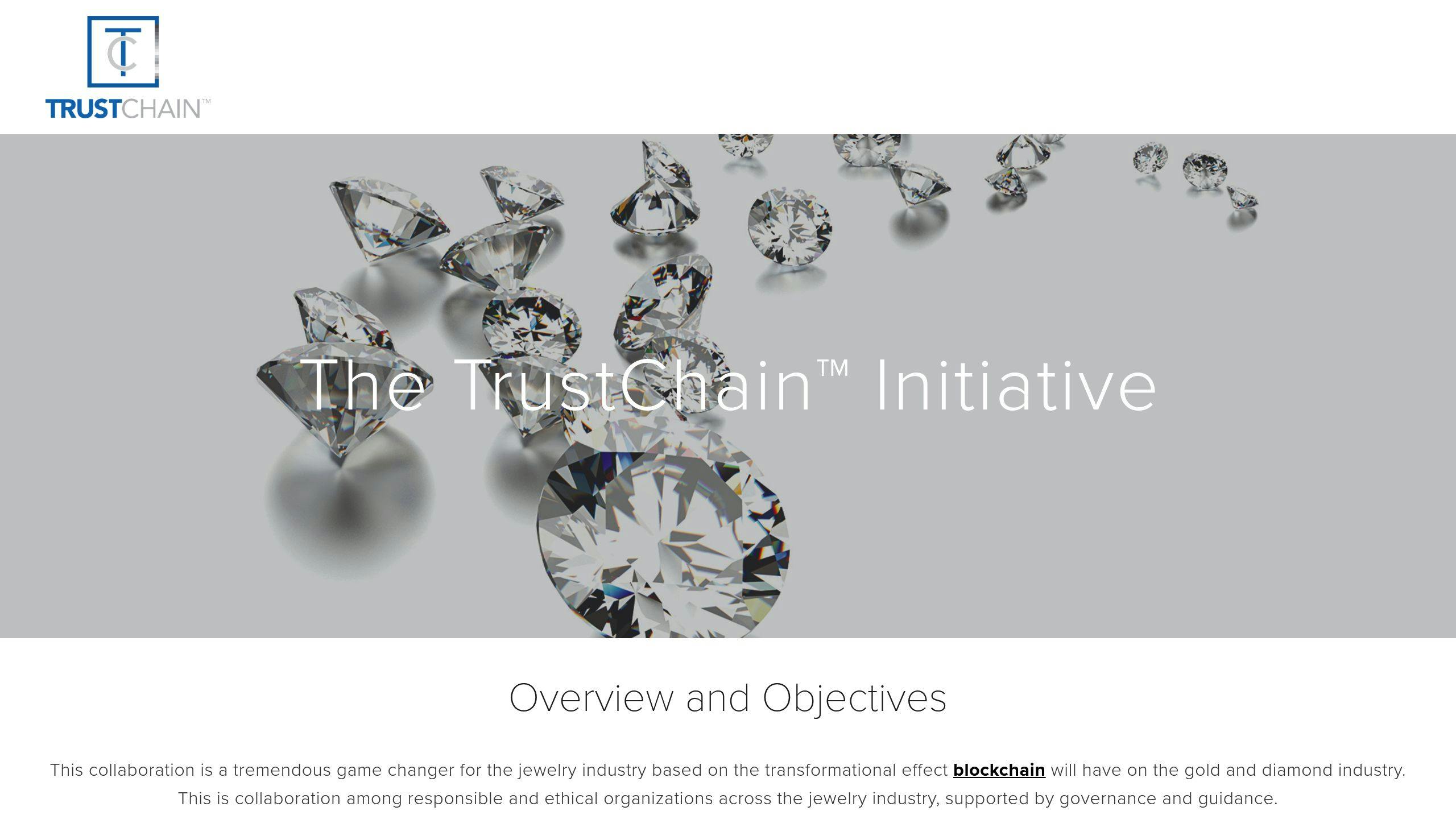Blockchain is revolutionizing diamond supply chain tracking. Here's what you need to know:
- De Beers' Tracr: Creates digital twins of diamonds, tracking 2.6 million rough and 400,000 polished stones.
- Everledger: Focuses on all diamond sizes, using public and private blockchains.
- IBM TrustChain: Tracks both diamonds and precious metals through the entire supply chain.
These systems aim to boost transparency and trust in the diamond industry. But they face challenges:
- Getting widespread industry adoption
- Ensuring accurate data input
- Balancing transparency with business privacy
Despite hurdles, blockchain is making the diamond supply chain clearer and more trustworthy. It's cutting fraud and helping consumers verify ethical sourcing.
As Feriel Zerouki from De Beers puts it:
"We truly believe that this platform will bring back trust within the industry and increase confidence in the diamond category as a whole."
The future looks bright for blockchain in diamonds, with more innovations likely on the horizon.
Related video from YouTube
1. How De Beers' Tracr Works

De Beers has created Tracr, a blockchain platform that tracks diamonds from mine to market. It's designed to tackle issues like spotting synthetic diamonds and meeting "know your customer" rules.
How It Records Information
Tracr creates a digital twin for each diamond by recording over 200 characteristics. This process starts at the mine:
- The producer scans the rough diamond
- They upload its "digital twin" to the blockchain
- Each handler adds their transaction data as the diamond moves through the supply chain
The result? A complete, unchangeable record of the diamond's journey.
How It Traces Diamonds
Tracr's tracing process is high-tech yet simple to use:
- Mines scan and register rough diamonds on Tracr
- Factories update the digital record during cutting and polishing
- An algorithm matches factory data with original mine data
- Distributors and retailers add their transaction info
- Consumers can check the diamond's full history at purchase
This system lets anyone verify a diamond's origin at any point.
Current Problems
Tracr isn't perfect. It faces some hurdles:
- It only tracks rough stones of 2 carats and up
- It needs more companies to join for best results
- Balancing transparency with business privacy is tricky
Effects on Industry Partners
Tracr is changing how the diamond industry works:
- It creates a "single source of truth", boosting trust in diamond authenticity
- Companies using Tracr can more easily meet bank requirements
- Early adopters might get ahead by offering fully traceable diamonds
- The digital system could cut costs and improve supply chain management
Bruce Cleaver, De Beers CEO, says:
"Consumers should be able to know there is an accurate register of a diamond's journey that provides assurance of its provenance and authenticity."
As of 2023, Tracr has tracked about 2.6 million rough diamonds and 400,000 polished ones. It's setting new standards for transparency and ethics in the diamond world, pointing towards a more trustworthy future in luxury gem trading.
2. What Everledger Does Differently

Everledger, a London-based blockchain company, is shaking things up in the diamond industry. While De Beers' Tracr focuses on big rocks, Everledger's got its eyes on ALL diamonds, big and small.
How It Records Information
Everledger's system is like creating a digital ID for each diamond. Here's how it works:
1. They scan the diamond to capture its unique features.
This isn't just a quick once-over. They're looking at over 40 different characteristics that make each diamond one-of-a-kind.
2. They create a digital twin on the blockchain.
Think of it as the diamond's online doppelganger. It's a perfect digital copy that lives on the blockchain.
3. They link this digital record to certification data.
This step connects the digital twin to all the important paperwork and certifications.
Leanne Kemp, Everledger's CEO, puts it this way:
"It gives us a global ledger, a global transparency over the supply chain and the chain of custody of the diamond. Where did the diamond come from? Was it a blood diamond? What's the provenance? What mine did it come out of?"
In other words, Everledger is creating a digital paper trail for every diamond, from the moment it's mined to when it ends up on someone's finger.
How It Traces Diamonds
Everledger's tracing method is like a Swiss Army knife - it's got multiple tools:
- They use both public and private blockchains. It's like having a mix of open forums and private chat rooms for diamond data.
- They pull in info from all over - insurance companies, police departments, certification houses. It's like they're building a massive diamond database.
- They use smart contracts. These are like digital assistants that automate a lot of the boring paperwork.
All this tech allows them to track diamonds in real-time and verify if they're the real deal and ethically sourced.
Current Problems
But it's not all smooth sailing. Everledger's facing some hurdles:
- Making sure the initial diamond data is correct and can't be messed with is tricky.
- Getting everyone in the diamond industry to jump on board is taking time.
- Convincing regular folks why they should care about blockchain-verified diamonds is an ongoing challenge.
Effects on Industry Partners
Everledger's platform is changing the game for everyone in the diamond biz:
- Retailers can now easily check if a diamond is legit and ethically sourced.
- Manufacturers can manage their supply chain better and worry less about fraud.
- Insurance companies get better tools to check claims and prevent fraud.
Gaurav Rana, Everledger's CTO, points out a big problem they're solving:
"Part of the problem is when these diamonds get lost or robbed, the diamonds actually end up in the police department and the police department has no way of communicating with the insurance companies."
Everledger's solution is like building a bridge between the cops and insurance companies. This could mean less insurance fraud and a better chance of getting back lost or stolen diamonds.
sbb-itb-d0b3b91
3. IBM TrustChain's Method

IBM's TrustChain Initiative uses blockchain to track diamonds and precious metals. It's all about making the jewelry industry more transparent and trustworthy.
How It Records Information
TrustChain creates a digital trail for each piece of jewelry. Here's the gist:
- Supply chain players record transactions on the blockchain.
- The system makes "blocks" with unique jewelry info.
- Once checked, these blocks join a permanent chain.
This way, you get the full story of each piece, from start to finish.
How It Traces Diamonds
TrustChain's tracing is thorough and involves several industry partners:
- Mines and refineries log where materials come from.
- Fabricators and manufacturers add production details.
- Retailers input final sale info.
Let's look at a real example. TrustChain tracked gold from a South Dakota mine to a Utah refinery, then to a Massachusetts fabricator. An Indian manufacturer used this gold to make engagement rings, which ended up at Helzberg Diamonds. UL kept an eye on each step, making sure everything was legit.
Current Problems
TrustChain is cool, but it's not perfect:
- Not everyone in the industry is using it yet.
- Making sure everyone inputs accurate data at each stage is tricky.
- Balancing openness with business privacy is a challenge.
Effects on Industry Partners
TrustChain is changing how jewelry businesses work:
- Buyers can check if their bling is ethically sourced.
- Companies can keep better tabs on their products.
- It's easier for businesses to follow the rules.
Mark Hanna, Chief Marketing Officer of Richline Group, says:
"This initiative is important for our industry as we seek to raise the collective responsibility and provenance practices to new heights."
It's not just about businesses, though. Bridget van Kralingen, IBM Senior Vice President, points out:
"Consumers care deeply about the quality and source of the jewelry they purchase. This is evidenced by the fact that 66 percent of consumers globally are willing to spend more to support sustainable brands."
What Works and What Doesn't
Let's compare the key players in blockchain technology for the diamond industry:
De Beers' Tracr
Pros:
- Creates a "digital twin" for each diamond, recording over 200 characteristics
- Tracks diamonds from mine to market
- Partners with industry leaders like Sarine Technologies and GIA
Cons:
- Only tracks rough stones of 2 carats and above
- Needs widespread industry adoption
- Struggles to balance transparency and business privacy
Everledger
Pros:
- Tracks all diamonds, regardless of size
- Uses both public and private blockchains
- Incorporates data from various sources, including insurance companies and police
Cons:
- Ensuring accurate initial diamond data input is tough
- Convincing consumers about blockchain verification importance
- Complete traceability isn't yet a reality
IBM TrustChain
Pros:
- Tracks both diamonds and precious metals
- Involves multiple industry partners
- Lets consumers verify ethical sourcing
Cons:
- Not widely adopted across the industry
- Ensuring accurate data input at each stage is challenging
- Balancing transparency with business confidentiality is tricky
Let's look at some real-world results:
"Tracr has found the sweet spot for the industry in terms of depth, certainty and scale", says Wesley Tucker, CEO of Tracr.
Tracr has tracked 2.6 million rough diamonds and 400,000 polished diamonds. But widespread adoption is still a challenge.
Everledger's CEO, Leanne Kemp, keeps it real:
"Perfect traceability remains an aspiration rather than a reality in many cases."
IBM's TrustChain showed promise by tracking gold from a South Dakota mine to engagement rings sold at Helzberg Diamonds. But scaling this process industry-wide is tough.
Some interesting stats:
- Diabot has processed over three million diamonds in two years
- The global diamond industry, worth $79 billion in 2019, could hit $123.83 billion by 2030
- Blockchain initiatives in jewelry might reach $5.4 billion by 2023
These numbers show how big blockchain could be for diamonds.
But it's not all smooth sailing. The industry needs to work together, deal with implementation costs, and tackle complex global supply chains.
Still, the perks are clear. Blockchain is making things more transparent, cutting down on fraud, and building trust. As Feriel Zerouki from De Beers puts it:
"We truly believe that this platform will bring back trust within the industry and increase confidence in the diamond category as a whole."
As the tech gets better and more people use it, we'll likely see even cooler solutions pop up in the diamond world.
Conclusion
Blockchain is changing how the diamond industry works. It's making the supply chain clearer and easier to track. Big names like De Beers, Everledger, and IBM are leading this change with new ideas.
Here's what's happening:
- De Beers' Tracr has tracked 2.6 million rough diamonds and 400,000 polished ones. It's creating one place for all the info.
- Everledger's system works with all sizes of diamonds. It uses data from many places to help track them better.
- IBM's TrustChain shows how we can track both diamonds and precious metals as they move through the supply chain.
These blockchain systems look good, but there are still problems. Getting everyone to use them, making sure the data is right, and finding a balance between being open and keeping business info private are all tough.
"Perfect traceability remains an aspiration rather than a reality in many cases", says Leanne Kemp, CEO of Everledger.
Even with these problems, blockchain is doing good things. It's making things clearer, cutting down on fraud, and helping customers trust more. Feriel Zerouki from De Beers puts it this way:
"We truly believe that this platform will bring back trust within the industry and increase confidence in the diamond category as a whole."
Looking forward, the diamond industry needs to:
- Get more companies to use blockchain
- Make sure the data put into the system is correct
- Come up with rules for how to use blockchain in the industry
As blockchain gets better and more companies start using it, we'll probably see even more new ideas. The future of tracking diamonds looks good, with blockchain helping to make the industry more open, ethical, and trustworthy.


Leave a comment